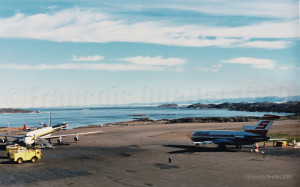(Precedent story: the lady who was robbed before my eyes)

On a 1989 autumn night in Iqaluit, on Baffin Island, Sterling’s Boeing 727 arrived from Europe and parked near the fuel tanks. From the Transport Canada flight service station tower (FSS), we could see the Canadian Customs and RCMP vehicles parked near the airplane, which was unusual. There was something going on as there were many people standing by the rear door of the plane, moving from one vehicle to the other. That was sure a lengthy stopover.
Few days later, on October 2nd 1989, the Journal de Montréal (one of the Montreal newspaper) published the following article: “[my translation] Two Polish citizen who had planned to request asylum in Newfoundland during the technical stopover of their plane on a flight from Gdansk to Vancouver were told on Saturday, by Canadian authorities, that the plane had landed in Canada’s far North”.
The article continues: “[my translation] The two men, whose identity was kept secret, still requested political asylum, said a RCMP police officer from Iqaluit, on Baffin Island in the Arctic. The Polish citizens, who were on a trip to relieve some fishermen on the west coast of Canada, thought they were in St John’s, Newfoundland capital, indicated the policeman in charge, Corporal Gary Asels”.
“The custom officer, using a map, showed them where Iqaluit [in the Nunavut] was located (2100 kilometers north of Montreal). They could not care less, as long as they were in Canada. They were very happy to be here, commented corporal Asels”.
I was told that in order to succeed with their escape from the plane, they had chosen a seat close to the rear stairway of the Boeing 727. They made sure to look like they were sleeping. When the stairway was lowered and the surveillance suspended for a quick moment, the two men just escaped through the stairway and were immediately on Canadian soil.
I am unfortunately unable to confirm today if they have been received as Canadian citizen or if they have been sent back in their country of origin.
(Next story: Iqaluit and the Persian Gulf War)
For more real life stories as a FSS in Iqaluit, click on the following link: Flight service specialist (FSS) in Iqaluit